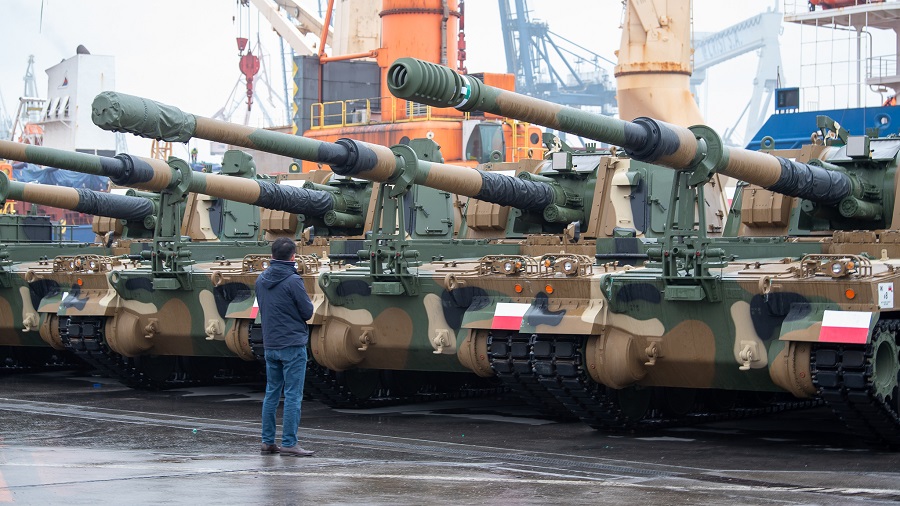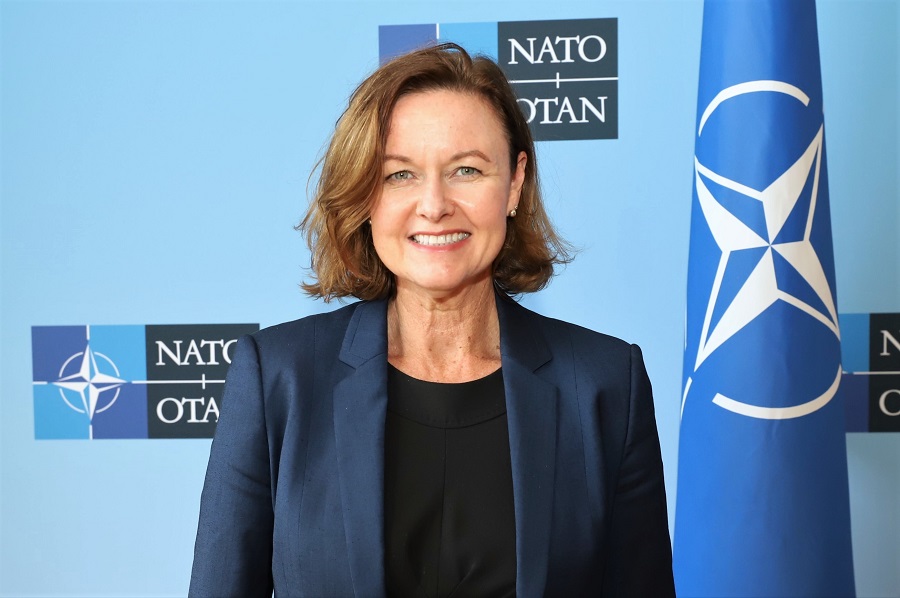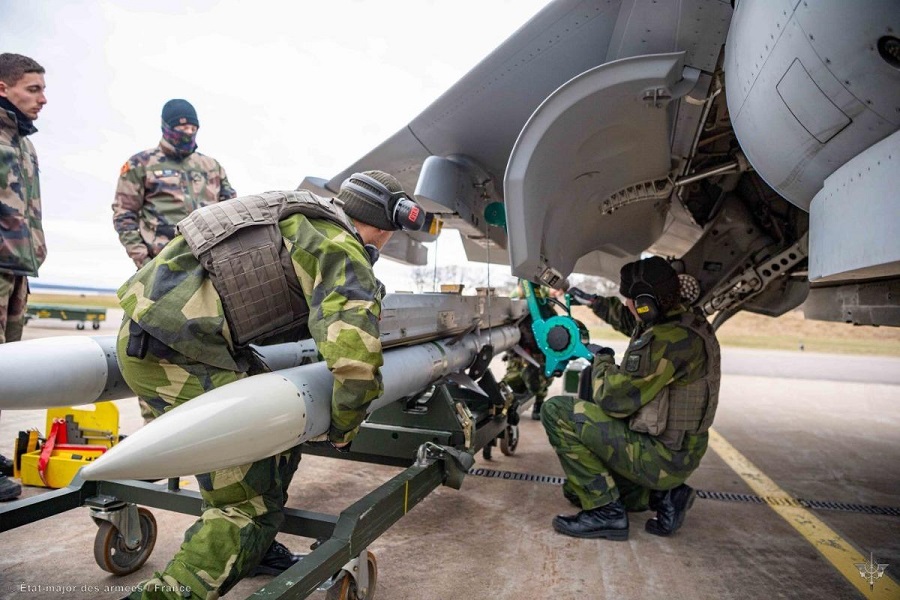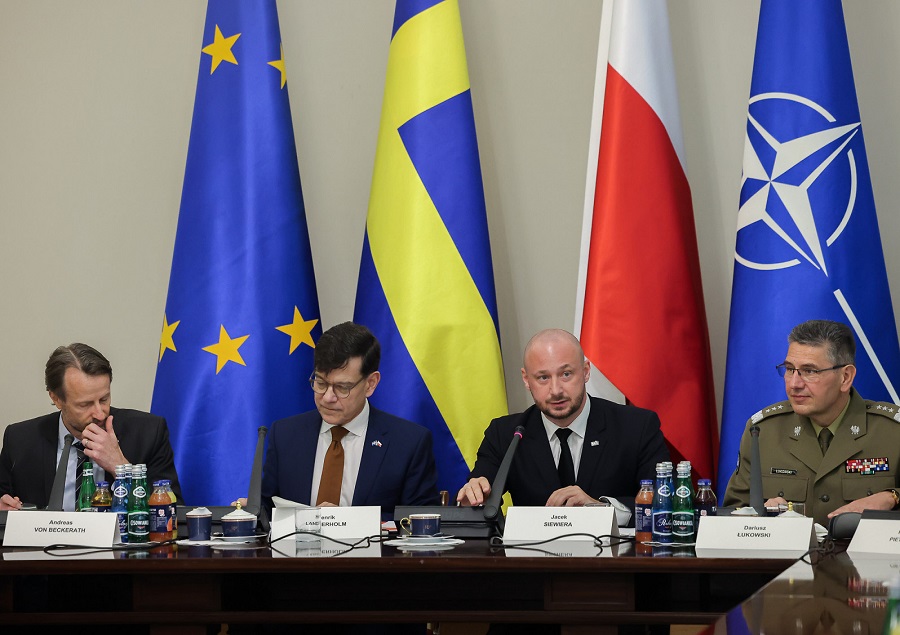Managers of South Korea’s largest arms companies producing combat aircraft, howitzers, tanks and surface-to-surface missile systems have a good reason for celebration. Within months of Russia’s invasion of Ukraine, Poland awarded these companies export contracts worth more than South Korea’s entire volume of arms exports to date.
Poland on a grand shopping spree
In August 2022, the Polish Armament Agency sealed the first deal to the tune of USD 5.8 billion covering the delivery of 180 K2 main battle tanks and 212 K9 self-propelled howitzers. The contract value also covers logistics and training. The contracted armaments will be manufactured exclusively by the Korean arms industry or will be delivered directly from Korean armed forces’ stocks. The manufacturer of the K2 tanks is Hyundai Rotem and the K9 howitzers are produced by Hanwha Defense (part of the Hanwha Aerospace group).
However, Polish tank and howitzer purchases seem far from finished. Earlier, in July 2022, the Polish Armament Agency signed three framework agreements with Korean companies. These were for the purchase of a total of 1,000 K2 tanks (including 820 of the K2PL version, which would be produced under licence in Poland, at least partially) and a total of 672 K9 howitzers (including 624 of the K9PL version, which would also be produced in Poland). The framework agreement also mentioned 48 light multi-purpose aircraft (36 of which would be FA-50PL versions).
The executive contract with Korean Aerospace Industries (KAI) was signed by the Polish Armament Agency in September 2022. Its value is approximately USD 3 billion, covering the delivery of a total of 48 FA-50 Golden Eagle aircraft, of which 12 will be handed over to Poland with the base configuration as operated by the South Korean Air Force. This delivery is to be completed as early as 2023. In turn, another 36 aircraft (designated as FA-50PL) will be adapted to the specific requirements of the Polish Air Force (above all, they will be equipped with AESA radar), and their deliveries are scheduled for 2025-2028.
In November 2022, Poland signed another contract worth USD 3.55 billion with Hanwha Defense. The contract is for 218 MLRS K239 Chunmoo launchers together with logistics and training packages. The contract also covers ammunition, including ‘several thousand’ 239mm calibre precision-guided ammunition (with a range of up to 80km) and 600mm KTSSMs (with a range of up to 290km). Deliveries are to take place between 2023 and 2027, with Poland to receive the first 18 launchers in 2023.
As much as the Polish arms industry was completely excluded from the other contracts signed with the Republic of Korea, it will only play a minor role in this one. This is because the Korean launchers will be based on an 8×8 chassis to be manufactured by the Polish company Jelcz. The launchers will also receive communication systems and the Integrated Combat Management Systems (ICMS) TOPAZ, which is manufactured by another Polish company, WB Group.
In the shadow of the American giants
These purchases sent shockwaves across Poland. Open biddings to allow other manufacturers of military equipment to join the proceedings preceded none of the signed contracts with Korean companies. The weapons systems purchased by Warsaw (tanks, aircraft, howitzers and MLRS systems) had not even been tested by the Polish armed forces.
These purchases were also not included in the Plan for Technical Modernisation of the Polish Armed Forces for 2021-2035, which the Polish Ministry of National Defence approved in October 2019. However, the change in plans regarding the modernisation of the Polish military and the decision to rapidly accelerate it following 24 February 2022 is understandable.
In Poland, however, experts are puzzled as to why Warsaw decided to make such massive purchases from the Republic of Korea of all places rather than the United States, as has been the cases with all of Poland’s largest arms contracts to date. Until now, the Polish defence ministry had planned for the ground forces modernisation, including armoured forces and rocket artillery, to rely on US companies. In 2019, the Polish government bought 20 M142 HIMARS launchers from the US for USD 414 million, along with a training and logistics package, ammunition, vehicles, as well as evacuation, technical support and command systems. Warsaw had in fact made plans to ultimately arm its artillery with many more HIMARS launchers. Therefore, in May 2022, the Polish government inquired Washington about the possibility of purchasing 500 more launchers. However, it turned out that the US defence industry was unable to deliver such an amount of equipment within the timeframe expected by the Polish side. After the outbreak of the Russian-Ukrainian war, the HIMARS systems gained worldwide recognition and demand for them skyrocketed. Warsaw’s final decisions regarding the purchase of more M142 launchers have not yet been finalised, but Lockheed Martin has recently declared that it would be able to supply Poland with around 200 of them.
The situation is similar with the purchase of tanks. In April 2022, Poland signed a purchase contract with the US for M1A2 SEPv3 Abrams tanks worth a total of USD 4.75 billion with the delivery period spread over 2025-2026. In turn, in July 2022, the head of the Polish defence ministry, Mariusz Błaszczak, announced that Poland would buy an extra batch of 116 Abrams tanks of the older type, the M1A1.
As for cannon artillery, i.e. self-propelled howitzers, the US does not currently offer modern weapon systems in this particular class. There are ongoing programmes in the US to modernise self-propelled artillery.
Until now, the modernisation of the Polish Air Force basically seemed to be an exclusive domain of the US industry. Polish military aviation currently operates 48 F-16 C/D aircraft. In 2020, Warsaw signed a purchase contract for 32 units of the F-35A aircraft worth US$4.6 billion in total. Representatives of the Polish Ministry of National Defence and the Air Force in early 2022 went on record as saying that Poland intended to buy another batch of F-16 aircraft (to replace the Soviet-era Su-22 and MiG-29) or to purchase F-15s. As it happened, however, the US defence industry in both cases was unable to deliver these aircraft within the timeframes required by the Polish side.
The above brief overview of the arms contracts concluded by Poland and the United States to date indicates that this year’s multi-billion dollar deal for Warsaw to acquire armaments from South Korea is complementary to purchases made in the US. Due to the specific nature of the arms business and the special political ties between Warsaw and Washington, it is highly unlikely that Poland would have decided to sign such major deals with Korean partners unbeknownst to US. What we see here then is a market partition, with Washington allowing these contracts to go to a third party in the face of a pressing need to beef up Poland’s defence capabilities, because it was out of capacity itself to fill that demand within the required time. However, this will not shift Poland’s general direction and American defence industry probably will continue in the foreseeable future to be the main supplier of weapons to the Polish army. That is, of course, unless there is a change of government in Poland in the near future, an option that is on the table since the extremely pro-American ruling party seems set to suffer a defeat in the upcoming 2023 election.
Recently, there have been several articles in the European press indicating that Washington should be concerned about the whirlwind entry of the Korean defence industry into the European market. However, it seems that if there is anyone who might be concerned about this situation, it is the European defence industry, which may feel threatened by the appearance of the ‘Asian tiger’ on the scene.
Turned their backs to Europe
There is no doubt that by signing huge arms contracts with the Republic of Korea, the Polish government has made a strictly political decision, a complex and serious one. In a sense, the message sent by the Warsaw government could not have gone unnoticed by its EU partners. After all, there is no shortage of manufacturers of tanks, self-propelled howitzers or combat aircraft in Europe. The same message features in other areas than armaments as well.
By reaching Poland with its weapons systems, South Korea try to pushed the European giants out of the market. Sights were set on these contracts by such companies as Germany’s Rheinmetall (incidentally Poland currently operates more than 100 Leopard 2 tanks, now under modernization with German assistance) and Kraus-Maffei Wegmann (manufacturer of Panzerhaubitze 2000), France’s Nexter (manufacturer of the Ceasar howitzer), Italy’s Leonardo (Poland currently has a fleet of 16 M-346 Master trainer aircraft) and several other large companies. It seems that in this situation, the most frustrating thing for European companies is that they have not even been invited to present their offers, as the Polish Ministry of National Defence neither engaged in any competitive bidding nor organised any preliminary testing of off-the-shelf equipment before signing the deals with Korea.
This is a great loss for the European defence industry, as the delivery of such sizeable orders – initially only for the Polish customer – could have been a starting point for larger international projects relating to tanks or self-propelled howitzers.
The European industry finds the situation threatening in how Poland ordering such a vast amount of equipment has done a huge favour to Korean companies, allowing them to tap the EU and NATO markets. In this way, Korean business gained a major advantage in negotiations with potential customers, whom they will be able to attract with interoperability, regional service and logistics centres as well as technology transfer. The Koreans are already taking advantage of these points. Let us recall that in October 2022, the manufacturer of the K2 tank, Hyundai Rotem, signed an agreement with the Norwegian company NAMMO, concerning the development of 120 mm ammunition for K2 tanks. This is part of a marketing ploy. Norway is currently finalising the selection of a tank for its land forces, and one of the vehicles on offer is the Korean K2.
Poland’s purchase of the K2 tank virtually closes the Polish market to armoured products from European manufacturers for many years. This means that the largest country on NATO’s eastern flank will certainly not become a user not only of new versions of the Leopard or MBT tanks, but also of the new European tank to be developed under the MGCS programme.
This is also true of other weapons systems, such as aircraft. For several years, Poland has been offered the Eurofighter aircraft, heavily promoted there by the Italian company Leonardo. Although the Polish Air Force will need to buy new multi-role or air superiority aircraft in the coming years, Warsaw is unlikely to acquire another type of machine. It is probably that in the coming years Warsaw will order another batch of F-16 aircraft from the United States.
Because of political decisions concerning arms purchases, Poland is turning its back on the European defence industry, choosing instead to collaborate with either the United States or the Far East. On the other hand, we should remember that Poland invests a part of its budget for the modernisation of the armed forces in the European industry. In that context, we should mention the programme for the construction of three multi-purpose frigates (the main partner is the British Babcock, and the ships themselves will receive weapons systems manufactured by e.g. MBDA or Thales), the construction of a short-range air defence system and a tank destroyer (here, the main partner is MBDA, the manufacturer of CAMM and CAMM-ER air defence missiles and Brimstone anti-tank guided missiles). In addition, Warsaw has also made many minor deals with European arms merchants.
As for technical specifications of the purchased equipment, they are comparable with analogous European products. European tanks are very good, howitzers perform well in Ukraine, and aircrafts have a great number of satisfied users. In the Polish case, however, what tipped the scales were not technical parameters, but simply politics. Not irrelevant are also the short delivery times that the Koreans were able to propose partially because much of the equipment will come from Korea’s own resources. With the current geopolitical crisis, which European country would be able to give so much support to its own arms dealers?
Polish industry backed into a corner
If there is anyone else who may be concerned about Poland’s purchases from Korea, it is the Polish defence industry, which will play almost no part in the production of equipment, meaning that only a trace amount of the several billion USD spent will return to the Polish economy. This is even more puzzling because the national industry in Poland has weapons systems analogous class to some of those ordered from Korea.
A case in point is the Polish 155mm Krab self-propelled howitzer, which has performed excellently in Ukraine’s defensive operations against Russian aggression. Indeed, Poland has donated dozens of such howitzers to Ukraine. They are produced by the state-owned company Huta Stalowa Wola (HSW), and the Krab itself was in fact developed in cooperation with the Korean company Hanwha Defense, which transferred to Poland the technology for producing the howitzer chassis (the Krab uses the same chassis as the K9 howitzer). The decision to purchase such large quantities of K9 howitzers instead of increasing domestic output seems incomprehensible to some Polish managers and experts. The Polish industry would certainly be unable to work to tight deadlines requested by Warsaw, but considering Poland’s strategic interests, it might still be a good idea to wait for domestic capacity to grow.
The Huta Stalowa Wola is the manufacturer of the new Borsuk floating infantry fighting vehicle. This is a new product, developed entirely by Polish armaments companies. It has not yet entered service, but tests are just finishing and contracts for the supply of these vehicles could soon come into effect. Meanwhile, the Koreans are also offering Poland their AS-21 Redback infantry fighting vehicle, which is also currently being tested by the Polish military. This may mean that part of this cake will be taken away from Polish companies and go to the Korean industry (the Polish armed forces’ requirements are estimated at over 1,000 new vehicles).
As for the purchase of the K2 tank, the story is so long that it would require a separate discussion. For about two decades, the Polish military and politicians have been planning to launch a large national armament programme designed to build a fully Polish new generation tank. The programme was even given a name – Wilk (The Wolf). Of course, the Poles assumed that they would invite foreign technological partners to cooperate, and one of them was none other than the heavily self-advertising Hyundai Rotem. At the time, the Korean company was proposing an extensive technology transfer to Poland, allowing that country to customise a version of the K2 tank to its own needs, and ultimately develop a new type of tank. The study work was at such an advanced stage that Hyundai even today has detailed plans for the new tank and the division of tasks between individual Polish companies. Over the years, the company has been in talks with many potential partners and thus has a detailed map of the competences of the Polish defence industry. In this context, it is even more surprising because Poland decided to throw the project in the bin and buy ready-made tanks from the Koreans, with zero involvement of its own industry.
Theoretically, the participation of Polish companies in the production of Korean weapon systems was included in the framework agreements concluded by the Polish defence ministry. For the time being, however, it has not translated into implementation agreements, i.e. actual orders. It is therefore unclear to what extent, and if at all, this opportunity will be materialise in the future, but it unlikely to do so. All the more so as there may be a change of government in Poland next year, which is likely to have a different vision of arms policy and be more amenable to partnership with the European defence industry.
A headache for commanders and logisticians
Poland’s purchase of Korean weapons systems is certainly giving Western European planners and NATO itself a headache. In recent times, ‘interoperability’ has been the buzzword in NATO communiqués, and the course of military action in Ukraine proves that it is not gun-toting soldiers but logisticians who win wars.
Meanwhile, Poland’s introduction of Korean weapons into service will make the logistics of defence operations on NATO’s eastern flank more difficult and complex. In a few years’ time, Poland itself will be using several types of tanks (Leopard 2, M1A2 and M1A1 Abrams, K2, T-72, PT0-91), with NATO tanks to follow (German Leopard, French Leclerc, British Challenger, post-Soviet tanks of other Central and Eastern European countries). Securing the supply of spare parts, consumables and ammunition for all of these vehicles will be extremely complicated, and simply hellishly expensive. The situation will be similar with self-propelled howitzers. Poland will have the Krab and K9, the Germans – the Panzerhaubitze 2000, the French – the CEASARs, the Slovaks – the Zuzanas and Danas, the Americans – the Paladins, the British – the AS-90, etc. All this will require unimaginably complex logistical arrangements.
The same problems, only to a slightly lesser extent, will occur if Poland is forced to conduct defence operations on its own for some time. It is anyone’s guess how Polish logisticians intend to solve this problem, but it poses a serious risk to the effectiveness of defence operations for the future.
A logistical risk also arises from the distance from the Republic of Korea to Europe. If the maritime routes from the Korean peninsula are blocked (e.g. by China as a result of geopolitical tensions in the area or even armed conflict), European clients of Korean arms companies will remain cut off from the supply chain. This would seem to be of strategic importance in the event of a large-scale conflict. For this reason it would be safer for Poland to base its logistics on European suppliers.
On the other hand, there is currently a growing tendency in the European Union and NATO towards integration of in-service weapons systems and increasing interoperability. Therefore, it is possible that Korean companies will use that fact to their advantage and market their offering – such as the K2 tank or the K9 howitzer – to NATO’s other eastern flank countries. The associated threat that European defence industry companies must feel today is obvious. All the more so because Korean companies enjoy Washington’s good graces.
The biggest winner – the Korean arms business
The biggest winner in the arms purchase situation discussed above is not the Polish army at all. True, they will receive new equipment quickly, but it will be of a new type for which many soldiers will have to be trained. The army will also have to build further logistical chains to secure the continuity of operation for K9 howitzers, K2 tanks, FA-50 aircraft and K239 MLRS systems.
The Polish government has certainly made another friend all the while acting loyally to Washington. Although the new friend is geographically just as distant as the United States, it is nevertheless offers broad potential for technological cooperation, including in the civilian domain. The Koreans are interested in implementing nuclear power projects in Poland and building a gigantic airport and transport hub in the centre of the country – the CPK.
The Korean industry will introduce a number of its products to the European Union and NATO through contracts with Poland. It will gain additional marketing arguments and will be able to emphasise that the equipment it offers is operated by NATO troops. Certainly, the first object of Korean companies’ marketing efforts will be the countries of Central and Eastern Europe, which are rapidly increasing budgets for the modernisation of the armed forces and will be making significant arms purchases in the coming years, such as Lithuania, Latvia, Estonia, Romania, and in the longer term also Ukraine, which will have to rebuild its defence capabilities after the end of the war with Russia.























